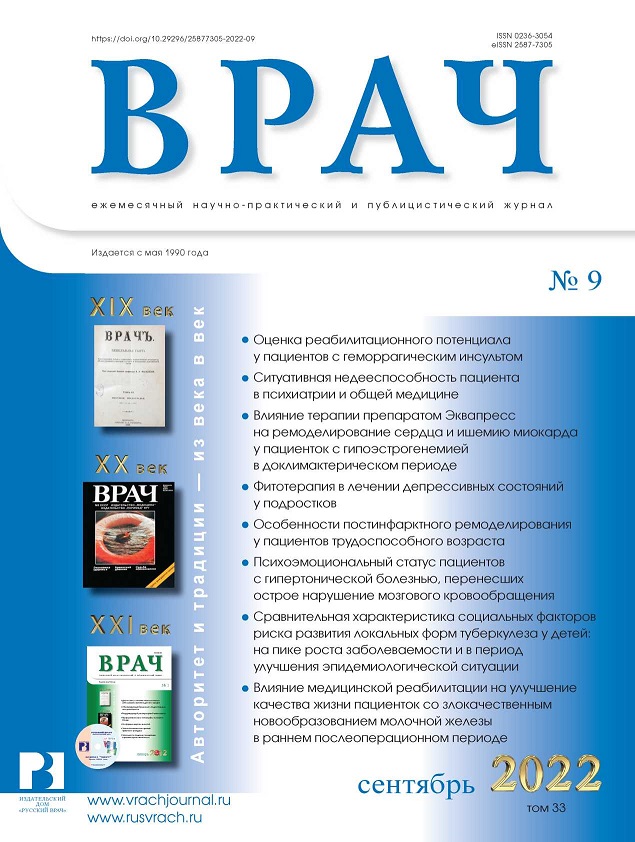Phytotherapy in the treatment of depressive states in adolescents
- Authors: Elistratov D.G.1, Grigoryev K.I.2
-
Affiliations:
- LLC «Parafarm»
- N.I. Pirogov Russian National Research Medical University, Ministry of Health of Russia
- Issue: Vol 33, No 9 (2022)
- Pages: 32-35
- Section: Pharmacology
- URL: https://journals.eco-vector.com/0236-3054/article/view/114683
- DOI: https://doi.org/10.29296/25877305-2022-09-05
- ID: 114683
Cite item
Abstract
Depression among children and adolescents Is relatively common but frequently undiagnosed. Early detection of depression In young patients contributes to the efficiency of therapy and to a substantial improvement in quality of life. Combination treatment with psychotherapy and the herbal remedy Hypericum P (Hypericum perforatum) is the safest method for treating children. Hypericum P is designed using Russians unique cryopreservation technology. The paper considers the pharmacotherapeutlc mechanisms of human exposure to the medicinal plant Hypericum P that is a natural antidepressant and has great potential to treat adolescent mental illness. In addition, the administration of the drug does not cause unwanted reactions.
Keywords
Full Text
About the authors
D. G. Elistratov
LLC «Parafarm»
Email: dge117@mail.ru
Penza
K. I. Grigoryev
N.I. Pirogov Russian National Research Medical University, Ministry of Health of Russia
Author for correspondence.
Email: DGE117@mail.ru
доктор медицинских наук, профессор
MoscowReferences
- Подольский А.И., Идобаева О А, Хейманс П. Диагностика подростковой депрессивности. Теория и практика. СПб: Питер. 2004; 202 с.
- Иванова Т.И., Пушкарева Д.В. Распространенность и симптоматическая структура расстройств настроения депрессивного спектра у школьников г.Омска. Омский психиатрический журнал. 2017; 1 (11): 5-11.
- Киселева М. Г. Депрессия у детей младенческого и раннего возраста. Национальный психологический журнал. 2017; 4:104-13. doi: 10.11621/npj.2017.0410
- Gledhill J., Garralda M E. Sub-syndromal depression in adolescents attending primary care: frequency, clinical features and 6-month outcome. Soc Psychiatry Psychiatr Epidemiol. 2013; 48 (5): 735-44. doi: 10.1007/s00127-012-0572-z
- Dennison M L The importance of developmental mechanisms in understanding adolescent depression. Soc Psychiatry Psychiatr Epidemiol. 2016; 51 (6): 791-3. doi: 10.1007/S00127-016-1216-5
- Hetrick S.E., McKenzie J.E., Bailey A.P. et al. Newer generation antidepressants for depression in children and adolescents: a network meta-analysis. Cochrane Database Syst Rev. 2021; 5: CD013674. doi: 10.1002/14651858.CD013674.pub2
- Otasowie J., Castells X. Ehimare U.P. et al. Cochrane Database of Systematic Reviews. Tricyclic antidepressants for attention deficit hyperactivity disorder (ADHD) in children and adolescents. Cochrane Database Syst Rev. 2014; 9: CD006997. doi: 10.1002/14651858. CD006997.pub2.
- Мазаева Н.А. Подростковые депрессии: взгляд на проблему (по данным зарубежных публикаций). Психиатрия и психофармакотерапия. 2017; 19 (3): 25-34.
- Турищев С. Формирование вектора психического комфорта фитосредствами. Врач. 2008; 3:43-5.
- Ng О.Х., Venkatanarayanan N. Но C.Y.X. Clinical use of Hypericum perforatum (St John’s wort) in depression: A meta-analysis. J Affect Disord. 2017; 210: 211-21. doi: 10.1016/j.jad.2016.12.048
- Воробьева O.B, Пилипович А.А, Фатеева В.В. Влияние эндотелиального воспаления на депрессию у пациентов с церебральной микроангиопатией: проспективное исследование. Неврология, нейропсихиатрия, психосоматика. 2022; 14 (1): 32-7. D01:10.14412/2074-2711 -2022-1 -32-37
- Мазур М.Н. Зверобой продырявленный - альтернатива современным антидепрессантам. Вестник фармации. 2001; 3-4: 28-30.
- Голяк Ю.А., Хишова О М. Разработка состава капсулы измельченной травы пустырника. Вестник фармации. 2006; 4:3-10.
Supplementary files






